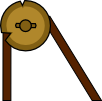Lesson 2
 Pulley
Pulley
Data Collection::
Table 3: The Pulley
Click on the numbered button to select the number of supporting ropes you want to test. Click [Pull]
In your lab packet, record the number of supporting ropes, the effort applied to the rope, and the distance the rope was pulled. Click [Release]
Select each of the 3 other pulley arrangements and repeat the test. Remember to record all data on Table 3 in your lab packet before going to another test.
For each trial, the stone is lifted the same distance, and its weight remains the same. The work output for all tests is equal to the product of the weight and the distance lifted: 3,480 N X 1.3 m = 4524 N. Calculate the work input for each trial on Table 3 by multiplying the force applied by the length the rope was pulled. Compare your 5 values for work, and using complete sentences describe what you found.
Data Analysis - 2
The advantage gained by using a pulley, its mechanical advantage, is equal to the force applied to the resistance (3480 N) divided by the effort force applied to the rope.
Transfer the data needed from table 3 to table 4 and calculate the mechanical advantage (MA) for each of the pulley systems used.
Table 4


Talk Now - 2f
Check your results with your partner and discuss any patterns you can find. Use complete sentences to describe the relationship between the # of supporting ropes and the mechanical advantage of a pulley system.



